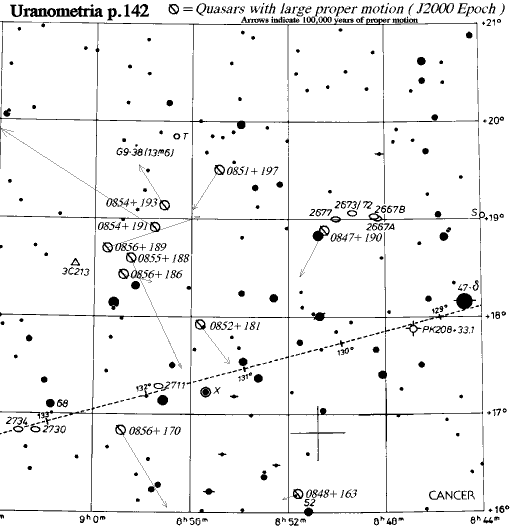

Star finder chart with locations and proper motions of 10 quasars (Arrows indicate 10,000 years of proper motion).
'motion' is connected with mualpha cos delta and mudelta by the following relation
'motion' = sqrt [ (mualpha cos(delta))**2 + mudelta**2) ]
where delta is the declination. If Ealpha, Edelta and E represent the mean (standard) errors in mualpha cos(delta), mudelta and 'motion' respectively, then from the standard theory for determining the mean error of a compound quantity, we obtain the following expression for E
E = sqrt [ (Ealpha mualpha cos(delta))**2 + (mudelta Edelta)**2 ] / 'motion'
The apparent red shifts are shown in the last column; all of these values are from Schmidt (1974), except those for PHL 1027, PHL 3632 and PHL 1186 (Burbidge, 1968), and PKS 0237-23 (Arp et al., 1967). It will be noticed that there are three quasars which have proper motions comparable to the largest value amongst planetary nuclei. These three quasars and their respective proper motions (in arcsec/yr) are
The mean error in the existing measurements of the proper motions of quasars are rather large. Any conclusion on this question is subject to this important qualification. In most of the reported cases, all that we can say is that the proper motion is about or less than 0.015 arcsec/yr. What does it mean in practical terms as regards to their distances ? Our study (Varshni, 1980) of planetary nuclei shows that at low values (< 0.015 arcsec/yr), the proper motion is almost independent of the distance. If a star has a proper motion of less than 0.015 arcsec/yr all we can say, from the trend of points on the proper motion-distance diagram (Varshni, 1977), is that very likely its distance is greater than 500 pc. It may also be pointed out here that the volume enclosed within this radius of 500 pc is only about (1/27000) of the total volume of the galaxy and the galactic halo. Quasars having proper motions less that 0.015 arcsec/yr have 99.996 percent of the volume of the galaxy and the galactic halo available to them. We may also note here that some of the bright stars in the solar neighbourhood have quite small proper motions. As an illustration, we give proper motions and distance for a few bright stars which have a proper motion less than 0.015 arcsec/yr and which lie within 500 pc from the sun. (Allen, 1973)
The evidence presented in a previous papers (Varshni, 1975, 1977, 1977, 1978 and 1979) and the present one clearly supports our theory that quasars, in general, are stars.
We can estimate the distances of quasars by comparing them with planetary nuclei. Perek and Kohoutek (1967) list 1036 planetary nebulae in their catalog. And additional 226 planetary nebulae, discovered during the period of 1966-1977, have been listed by Kohoutek (1978). Of these 1262 nebulae, 201 planetary nebulae have absolute galactic latitudes greater than 10 deg. Cahn and Kaler (1971) give distances for 127 such planetary nebulae. The distance distribution of these, excluding two distant ones, is shown below; the two exceptions are K2 8 (distance 24 kpc) and PS 1 (distance 25 kpc).

Histogram showing the distance distribution of 125 planetary nebulae which have absolute galactic latitudes greater than 10 degrees. (The distances are on Cahn and Kaler's distance scale.)
The average of the distances of these 125 planetary nuclei is 3.1 kpc, and the average of the apparent magnitudes of 85 planetary nuclei in this category for which data are available (Perek and Kohoutek, 1967) is 15.0. We shall find it convenient to discuss the apparent magnitudes and distances in terms of 'average' quasar. It is understood that there is a considerable spread on both sides of this average. If the distribution of quasars and planetary nuclei are similar, then this would indicate that the 'average' quasar (with |b| > 10 deg) is at a distance of about 3 kpc. We can also do some speculation regarding the absolute magnitude of quasars. The 'average' quasar has an apparent magnitude of 17.6 (Hewitt and Burbidge, 1980). Again assuming that the distribution of quasars and planetary nuclei are similar, this would indicate that the 'average' quasar is intrinsically fainter than the 'average' planetary nucleus. The photographic magnitudes of three near quasars, PHL 1033, LB 8956 and LB 8991 are 18.7, 17.9 and 17.3 respectively. This slender evidence appears to favor our speculation.
Purely as an academic exercise, we calculate the transverse velocities required for the three quasars PHL 1033, LB 8956 and LB 8991 on the cosmological red shift hypothesis. We take the smallest value of proper motion within the uncertainty range and assume the Hubble Constant to be 50 km/s/Mpc and q0=0. Then we find that in terms of the velocity of light c, Vt = 760c, 5200c and 2300c for PHL 1033, LB 8956 and LB 8991 respectively. Needless to say these values are without physical significance and clearly indicate that the cosmological red shift hypothesis is completely untenable (Varshni, 1974, 1974, 1975, 1976, 1976 and 1977).